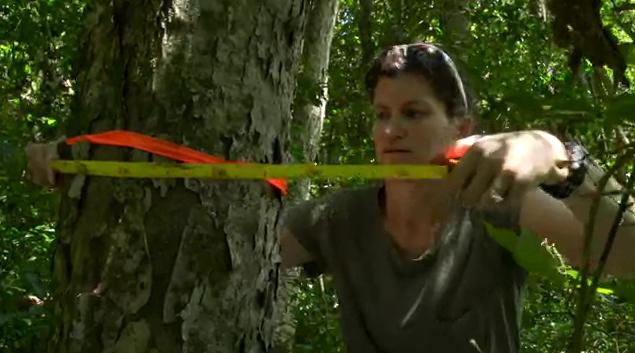IMAGE OF THE WEEK

Erica Smithwick studies the carbon stored in forests in South Africa during her 2016 Fulbright project. Smithwick talks about her research and teaching in a COIL Conversation, March 16, 10:30 to 11:30 a.m. EST. 313 Location: Keller Building, University Park, PA and online at https://meeting.psu.edu/coil. Registration required at https://goo.gl/Pqewsy
GOOD NEWS
- Cynthia Zook will be starting on March 20 as our new administrative support assistant (succeeding Missy Weaver). She comes to us from the University Faculty Senate Office as she was working with the Special Senate Committee on the Implementation of the General Education Reform and with the Special Senate Committee on the Implementation of LionPATH. Please stop by on March 20 to give Cynthia a very warm welcome.
- Two papers co-authored by Bronwen Powell have been cited in a news story on Mongabay
- The annual SWIG essay competition is accepted submissions around the theme of mentorship. Submit your work by March 27: http://www.geog.psu.edu/swig-essay-contest
- Joshua Inwood’s article, “Dealing with hate: Can America’s truth and reconciliation commissions help?” was published on The Conversation.
NEWS
Coffee Hour with Roger Downs: Incidental Learning about Geography: Saint-Exupéry and The Little Prince
There are formal and informal pathways for developing geographic knowledge and skills. Each pathway is characterized by a mode of learning, with distinctions between instructed and uninstructed learning, and intentional and incidental learning. Each pathway generates different understandings of the world. The scholarly discipline of geography is defined by the formal pathway, and that pathway is well-studied. The informal pathway is neither well-recognized nor well-studied. Instead, we lament about the persistence and prevalence of geographic ignorance. Nevertheless, to function people need to know about the geographic world: weather, roads, distances and directions, seasons, cities, hazards, vegetation. People develop an understanding of geography derived from everyday experiences. How do geographic knowledge and skills develop from everyday experience? Antoine de Saint-Exupéry wrote about flying mail planes in Africa and South America, and wartime flying in Europe. Geography underpins his books, not the formal geography mastered from school instruction, but the informal geography hard-learned from meeting challenges of navigation, storms, night flying with few instruments and little fuel, and searching for emergency landing places.
- Refreshments are offered in 319 Walker Building at 3:30 p.m.
- The lecture begins in 112 Walker Building at 4:00 p.m.
- Coffee Hour to go webcast
- Next time: March 24 with Antoinette WinklerPrins
Penn State’s Roger Downs to receive AAG 2017 Presidential Achievement Award
Roger M. Downs, the Ruby S. and E. Willard Miller Professor of Geography in the College of Earth and Mineral Sciences, has been selected to receive the American Association of Geographers (AAG) 2017 Presidential Achievement Award.
Pa. Agricultural College Herbarium has dappled history, deep roots
Ever wonder how you can identify a plant you’ve found in your yard or while conducting fieldwork? What about determining how plants in a particular location have adapted over time due to climate change? You can get help at the PAC (Pennsylvania Agricultural College) Herbarium, a kind of museum for plants.
“The PAC Herbarium provides a variety of services to the University and larger botanical community including research and teaching support, tours, and training workshops,” said newly appointed curator Sarah Chamberlain.
from the Centre Daily Times
Erica Smithwick sets out on a ‘grand adventure’
The title of “Globe-Trotting Adventurer” has officially passed from Indiana Jones to Erica Smithwick, an associate professor at Penn State whose research in the field of physical geography has taken her deep into the forests of South Africa. Smithwick happily balances continent hopping with a busy family life.
RECENTLY (OR SOON TO BE) PUBLISHED
Geography and the Study of Human–Environment Relations
By Karl Zimmerer
In The International Encyclopedia of Geography. 1–23.
Access DOI: 10.1002/9781118786352.wbieg1028
Human–environment geography is characterized by focused integration and synthesis of the in-depth analysis of both the multifaceted human conditions of interactions with the environment and the active dynamics of the biogeophysical world. The nine topical and thematic areas currently comprising human–environment geography are (i) human–environment interactions in hazards, risk, vulnerability, and resilience; (ii) land use, land systems, land change, and biodiversity; (iii) social-ecological and coupled human–environment systems; (iv) political ecology and human–environment relations; (v) human–environment relations in livelihoods and agricultural landscapes; (vi) resource political economy, management, and politics; (vii) food, health, and bodies in relation to the environment; (viii) environmental landscape history and ideas; and (ix) knowledge concepts in environmental management and policy. Finally, new trends are identified in order to understand the ongoing diversification and potential future expansion of human–environment geography.
Weight and Veterans’ Environments Study (WAVES) I and II
By Shannon N. Zenk, Elizabeth Tarlov, Lisa M. Powell, Coady Wing, Stephen A. Matthews, Sandy Slater, Howard S. Gordon, Michael Berbaum, Marian L. Fitzgibbon,
In American Journal of Health Promotion
Access 10.1177/0890117117694448
To present the rationale, methods, and cohort characteristics for 2 complementary “big data” studies of residential environment contributions to body weight, metabolic risk, and weight management program participation and effectiveness. A total of 3 261 115 veterans who received Department of Veterans Affairs (VA) health care in 2009 to 2014, including 169 910 weight management program participants and a propensity score–derived comparison group. Forty-four percent of men and 42.8% of women were obese, whereas 4.9% of men and 9.9% of women engaged in MOVE!. About half of the cohort had at least 1 supermarket within 1 mile of their home, whereas they averaged close to 4 convenience stores (3.6 for men, 3.9 for women) and 8 fast-food restaurants (7.9 for men, 8.2 for women). Forty-one percent of men and 38.6% of women did not have a park, and 35.5% of men and 31.3% of women did not have a commercial fitness facility within 1 mile.
